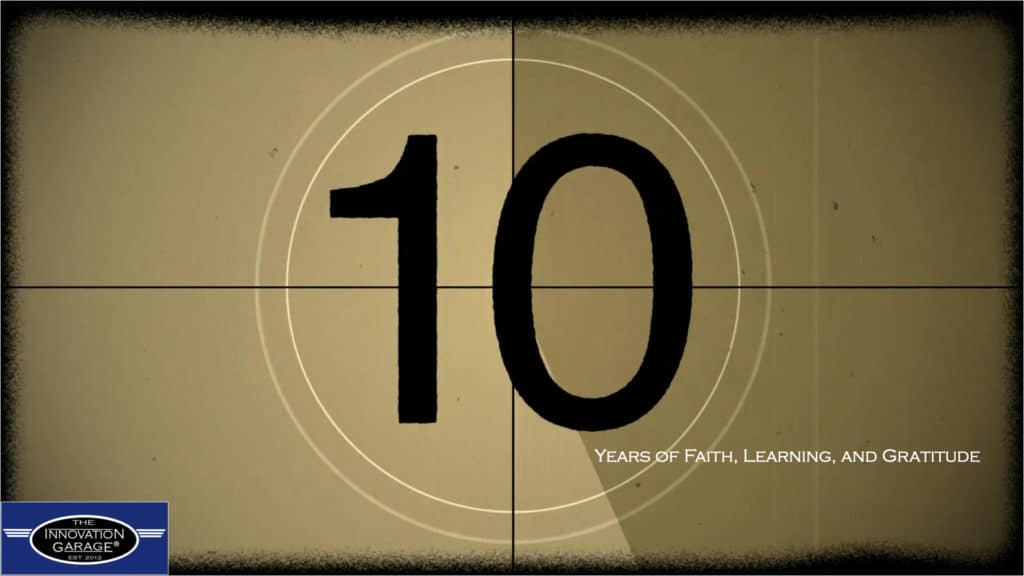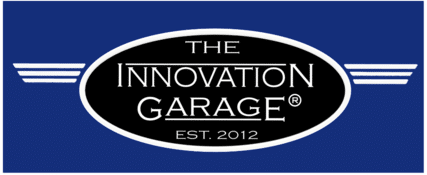
I’m runnin’ down a dream. That never would come to me. Workin’ on a mystery, goin’ wherever it leads. Runnin’ down a dream.
– Tom Petty
August 30th, 2022, represents a landmark milestone for The Innovation Garage. Ten years in business. Ten years since stepping out into the unknown and starting something.
In contemplating what to write about for the tenth anniversary, this article series is written with a specific intent—sharing what we are learning and answering some FAQs about the journey. Many attendees have been asking these questions in client sessions, large groups, and individual discussions. One of the best ways to provide the answers is to write about them.
In it’s full long-form reflection, located here, this article series also represents a celebration of effort. We share outcomes of the elements in our ideal design and what we continue to learn each day.
Shared later in this article series, you will find a top-ten list that is pressure tested in the real world, even after ten years in business. The Innovation Garage assembled this “top 10” learning list based on thousands of conversations—and hundreds of cups of coffee. Advice from close, trusted colleagues you might not know. As well as wise sages and influencers that you may have heard of at some point. In capturing this insight here, it might be that you have heard it all before. We are hopeful you will pick up some new context and insights that will be helpful.
We share these learnings, backstories, and what we consider as True North Principles. When designing your ideal adventure, use the lessons learned as pin drops to your roadmap of very own Hero’s Journey. Consider this a helpful traveler’s guide for your own experience. If you are looking for encouragement in finally taking that “big leap of Faith” for yourself, use these learnings as fuel.
As we now pass this ten-year “valley of death,” it is valuable to look back for a bit. With a business model understood yet continuously evolving, it’s an excellent time to reflect and capture the immense learnings and experiences from the last ten years.
What elements are critical in designing a business for the long haul?
Playing the long game regarding a time horizon is essential too. A question to ask of yourself might be, “What will the next twenty or twenty-five years look like if I do this?”
If you spend any time listening to the so-called “business gurus,” they will tell you that there are just a few valleys of death in business—the one-year, two-year, and five-year mark. The statistics say that most companies will fail after three years. 50% of businesses fail after five years, and 66% yield after ten years. The average survival rate of firms with a decade or more of business under their belts is 34.4%. So, maybe about three in ten chances of surviving beyond that. Many statistics indicate that only 25% of enterprises will last for 15 years or more.
So, why on earth would you risk starting something that, in the long run, only one in four businesses (just 25%) will ever see or experience?
You start because you want to see what will happen if you take the leap. The real payback is much more about the experiences you are having and are grateful to have. The reality is that there are multiple valleys of death. It’s your job to do your best, move through the ups and downs, and keep pressing forward. There are many ways the storms can come. It is incumbent on you to be in a position to be overly surprised by what may come.
Three design elements we try to anchor to each day help us do just that. Specifically, in our design, we have three parts:
Faith, Learning, and Gratitude.
Each is an integral component of our ideal design, and we will explore the faith component in this article.
Why is Faith important?
Faith, in its simplest form, is simply believing before seeing. Faith is essential because it helps give you the long-term fuel for vision. With Faith, you need to have a picture of what success looks like for you, and then you have to build it up and execute that vision.
When you start building something from scratch, you are often the only person with the vision. You are the only one who can see it. It might also be tough to explain the concept to others. And with that somewhat unclear vision, you cannot thoroughly explain, many questions come along for the ride, all spinning in your head simultaneously.
Positive and affirming questions like;
- Wouldn’t it be cool to design a new adventure?
- What should the focus and vision be?
- What is the time horizon?
- What is needed to get to the ideal design?
- What could you learn as a result?
Then some more stressful questions that drive uncertainty;
- Is there a viable end state that you can visualize to work backward?
- Will others support it?
- Will clients/customers pay for it?
- Who are the ideal clients/customers?
- What revenue will deliver profitable net margin growth?
- Will the efforts support the financial needs of those that may depend on me?
- If it fails, will those that depend on me have to live in a van by the river?
And, perhaps the most stress-filled question of them all;
- What if the endeavor is successful? Then what?
The reality is that there are a million questions. And, be ready for this; you will not have immediate answers to most of those questions. There is no magic formula or solution. At best, your efforts will be wrong but useful. Wrong in that you will be making tons of mistakes. Useful, though; you are getting closer to your ideal design as you fail forward.
In another way, thinking about the importance of Faith, you can compare and contrast two common types of fear. The fear of the unknown contrasts with the fear of missing out. These two types of fear create tremendous anxiety. They are classic opposing forces that always seem to be in tension. You are trying to determine for yourself what is the ideal ratio between those two forces.
To start something new and execute it, fear of missing out must exceed fear of the unknown. To explain in some more detail, suppose you don’t want to miss out on your potential vision and benefits of the ideal design for yourself and others. If that is the case, your fear of missing out on that new thing will need to be greater than your fear of the unknown. Your fear of missing out on the new adventure has to exceed your comfort level, of the fear of the unknown when compared to your current situation.
Each of your next-step actions towards your ideal design and the real energy you put into the next steps will help clarify your vision’s end state. Over time, this energy into uncertainty will be a helpful aid in driving down fear. And, as you progress, how each new experience continues to reinforce your Faith to continue to keep moving forward.
In every case, your Faith must transcend your fear. Daily.
Most creatives like musicians, entertainers, designers, educators, and yes, consultants, are, in their way, striving to design and provide a great user experience. And by participating in the experience, the designer is hopeful that the user truly learns and gains a meaningful outcome. We strive to do the same each day.
Our mission is to Make Things, Make Things Better, and Teach Others.® We will keep on this path of Faith, Learning, and Gratitude and see where it will take us.
And, as Tom Petty encourages, keep running down a dream.
At The Innovation Garage®
We help organizations grow. Providing education, tools, technology, and expert consulting in change management for strategy, innovation, and supply chain. Guiding leaders from startups to the Global Fortune 500 to intentionally self-disrupt their offerings and organizations. Delivering world-class education, tools, and technology on how to craft business operating systems focused on long-term profitable growth.
Share your contact info with us if you want to learn more, and subscribe to our blog.
If you’d like to join us at one of our upcoming events, visit our full events calendar.
Article Reference Statistics
https://www.entrepreneur.com/article/361350
https://www.zippia.com/advice/what-percentage-of-small-businesses-fail/
